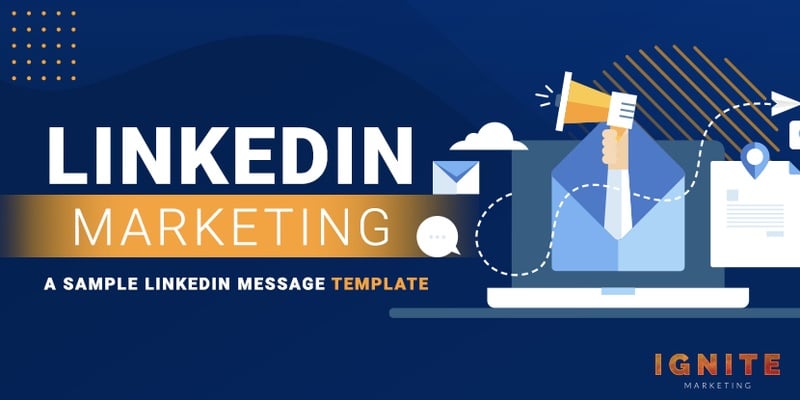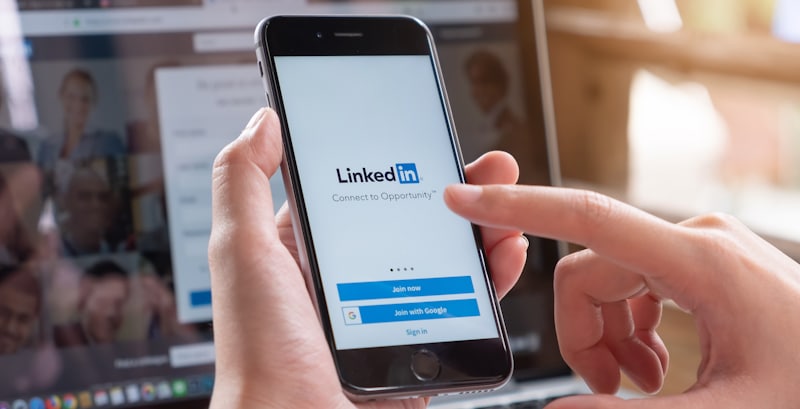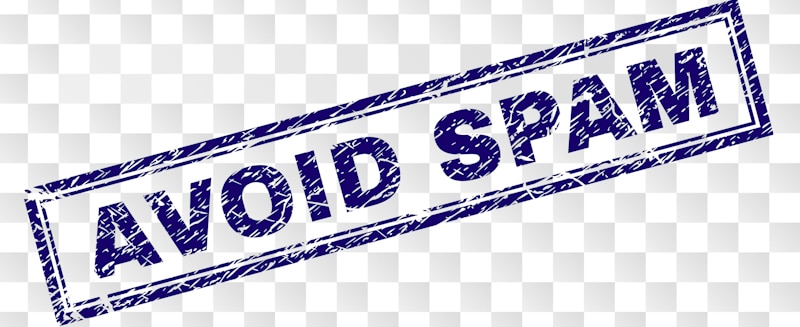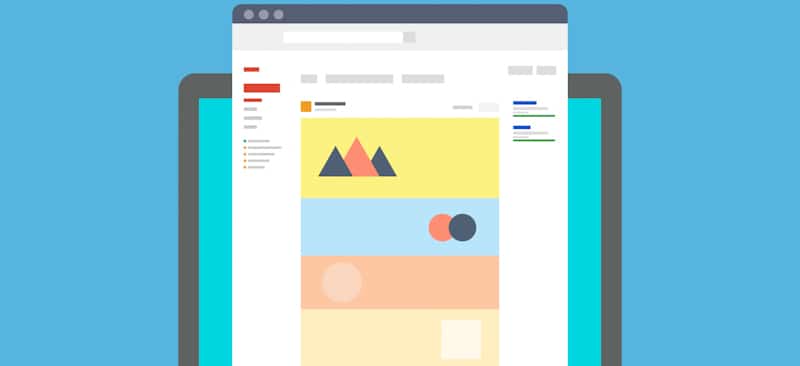


With more than 170 million LinkedIn users in the United States, it's easy to assume that engagements and conversions in LinkedIn are straightforward, but not until many prospects ignore your LinkedIn messages. And yet, brands can't stop sharing their success stories with LinkedIn messaging. You're probably wondering, what's not happening?
Best LinkedIn messaging tactics and strategies focused on voice, video, and text messaging — and showcased with actionable sample LinkedIn message templates, allow you to stretch your marketing efforts to your connections and groups. That assures quality leads, business appointments, and clients.
Ready to boost your LinkedIn connections, network, and marketing efforts with LinkedIn messages? Here's what we'll cover to make it a reality: What LinkedIn messaging means, why it's important, LinkedIn messaging tactics, and 3 sample LinkedIn message templates for inspiration.
Let's get going!

LinkedIn Messaging involves conveying information (messages) to your LinkedIn contacts. Messaging in this platform is the primary means of linking and initiating relationships with your new and existing connections. Note that LinkedIn only allows users to contact prospects they have a connection to — that's first-degree connections and members you share a group with.
Luckily, even without a direct connection, you can still send messages to everyone. How's that possible? Well, besides direct messaging, LinkedIn has other messaging features worth learning about. They include the following:
An InMail is a perfect choice to send private messages to prospects outside your network. But you must be a Premium and Sales Navigator user. Your InMail message needs to stimulate a conversation. That said, customize it naturally and to the point. You'll be surprised how many responses you get.
Send an invitation note to people you want to connect and keep in touch with. Invitation messages limit you to a text of not more than 300 characters. The good thing about invitations is, when crafted well, you get the prospect's attention and a chance to know each other, making it easy to accept the invitation.
You can now engage your connection with the 60-second LinkedIn voice messaging. You've probably not received a voice message. And that tells you people are yet to embrace this excellent feature. Ensure you personalize the content, keep it precise, remain friendly, and offer value if you want to be exceptional.
Videos are now revolutionizing LinkedIn like never before. From the profile, presentation, article content to messaging, being creative, more personal, and embracing the best video messaging practices gives you a competitive advantage in LinkedIn. A short and quality video message with a human touch converts pretty well.
Do you dread initiating cold calls or emails? Well, it happens to almost everyone. But guess what? You can now maximize on new avenues like LinkedIn messaging and boost your brand awareness, generate quality leads and scale your influence — without guesswork.
Here's more on why you should consider LinkedIn messaging?
You're probably in a hurry to send those messages, build a relationship with prospects and close the next available deal. Relax, it doesn't work like that.
Despite LinkedIn posing multiple ways to send messages, many users, even with complete LinkedIn profiles, find it hard to impress prospects or stand out as genuine brands.
Two main questions remain: What are you doing wrong? And how do you do it right? The answers lie in the LinkedIn messaging tactics below.

Ready to craft LinkedIn messages that prospects will open, read and revert? Prioritize the following tips, tricks, and hacks to stand out from the rest and scale your brand network and growth exponentially.
Let's get into it, starting with:
First things first! Why are you sending the message? To make sales instantly?
Let's be honest. A single message won't win you sales. Your goal should be getting a chance to start a conversation with your prospect and knowing more about them.
Why then should you be so self-centered in your reach? The majority of LinkedIn users focus so much on themselves and their capability to execute various roles and forget about the prospect.
That's a mistake, and many prospects won't spend their time on such messages. Don't be salesy and avoid pitching your services directly.
For a minute, forget about applauding the opportunity, product, or service that you have and craft a message directed to your prospect with a clear intention that you want to help them. You can also do some basic research to identify some challenges or any issue affecting the particular prospect directly. With that, you don't just send a message but a converting pitch.
But again, how will the prospect know about your capability and credibility without knowing more about you? Well, keep reading. In one of the sections (Show and Build Credibility) we will reveal how to build credibility in your message without talking too much about yourself.
Now, let's get to the LinkedIn messaging hacks to consider down the road, from the subject line, salutation, to signing off. Keep it here!
A random linked message to your first-degree connections might not require a subject line. But when it comes to engaging 2nd or 3rd-degree connections, you'll definitely need one. It's because LinkedIn InMail comes in handy, and there's a slot to have a subject line.
Your InMail might have premium content and an excellent call to action, but without a simple, friendly, and attention-grabbing subject line, chances of readership are low. 35% of your prospects decide whether to open messages, InMails, or emails based on subject lines or titles. It's important!
InMails attracts responses 3x more compared to cold emails. However, that doesn't come without prioritizing LinkedIn InMail best practices like including a perfect subject line.
Excellent subject line examples look like: "Thanks posting on (relevant topic)," or "Looking to connect."
That said, here's how to make your subject line highly effective:
Whether you're sending invitations, connecting messages, or InMails, never compromise the introduction part. In fact, introductions will reveal the integrity, intentions, and value you bring on board.
A look at a sample LinkedIn message template will help you out (more on this later). But first, you need to know the basics.
Let's look at two sections that you must prioritize during the introduction to transform your message.

It might look obvious mentioning salutation. But to be honest, many people are getting it wrong.
People still address prospects as "to whom it may concern." We don't do that in LinkedIn conversations. With access to the individual's profile, you have no reason not to address them with their name.
A wrong salutation shows you don't even know whether you're talking to a real person. The message won't be compelling enough to get prospects' time.
Greetings have a lot of power in any form of messaging. In LinkedIn, keep it professional while remaining friendly. A simple "Hi" accompanied with the prospect's name keeps your communication on point. Formality personalizes the salutation, creating some attention and receptiveness.
 Self-Introduction is Key
Self-Introduction is KeyDon't assume that every prospect you send a message to will first look at your profile before responding. It doesn't happen most times. We're all busy trying to beat deadlines, and browsing your profile might not be a priority at the moment—a sad reality.
Mention your name, the position you hold and where you work, or the company you represent. Keep it short. Remember, it's about your prospects, not you.
A long introduction full of chest-thumping is a waste of time — nobody will read it. It should come out simple like: "Hi, I'm Shawn Manaher, Founder Ignite Marketing..."
A message to prospects in or out of your network requires a strategy that hooks them to what you write. One simple approach is to connect based on prospect's relevant information, history, frequent undertakings, and everything in between.
But how exactly do you identify the common grounds and keep them reading your message? Sounds like another challenge, right? It's actually very simple. Here's how you do it:
LinkedIn groups host multiple users with similar or related professions. That means the group members share common views and interests. From here, you can contribute with ease and connect with prospects at different professional levels.
You don't need a LinkedIn Premium account to send private messages to prospects you share a group with. Use the "common group opportunity" to get the recipient's attention on what you write. Your statement should look like this: "Hi Mary, I have noticed that you're a member of Atlanta KK Law Firm Group. I feel..."
Mentioning a shared connection works pretty well if a prospect doesn't know anything about you. The "How You're Connected" feature will help you spot the mutual connections.
Since you don't want to look like a total stranger wasting the recipient's time, mentioning a mutual colleague or friend boosts the acceptance rate and might win you a conversation.
It's because mutuality creates some trust and assurance. Just like it will be easy for a lawyer to get an InMail response from a divorce client when they indicate a friend (mutual connection) mentioned they have an issue that requires immediate action.
Just like you choose to comment mainly on posts that revolve around your industry, the same happens to the majority of LinkedIn users. If you've shared a post and received quality responses, whether it's suggestions, more contributions, clarifications, or appreciation for creative contributions, that's a gateway to send a connection request.
In your message, don't forget to mention that the posts prompted you to make a move. It shows you're sincere and know who's worth connecting with. Many prospects appreciate that. A simple example is, "Hi Alex, your comment on Chiropractors Leveraging Technology post shows..."
If you're a personal injury attorney and you mention this to a prospect, "I noticed you spent the last 12 months contemplating on whether to sue your employee due to work-related injury. So am I..." you can be sure to get a response.
Experience doesn't have to be what's indicated on the prospect's profile. At times, they'll share their daily encounters via posts, and if you notice that in groups or Newsfeed, use it as a commonality aspect.
Are you tempted to connect with a prospect because you met them in a chiropractic seminar? Mention it. We're all fond of forgetting, and there's a high possibility that the prospect doesn't remember your name, especially if you've taken so much time before reaching out or you were not in the limelight during the event. Consider this line: "I met you at X event."

If you send a message and the receiver has to decide whether it's worth their time, then it's way too long. While everybody checks the messenger often to know what's new, nobody wants to waste time reading a lengthy message.
Keep it short and go straight to the point. Persuade without being wordy. LinkedIn prospects love short messages and will read them even more than once.
Remember, your focus should not just be reaching out but customizing your message such that your prospects get lured to what you say to the extent of showing more interest in what you do. Simply put, arouse their interest and capture their state of mind. Here are two more important things to note here:
If a prospect thinks that the message isn't directly targeted at them, you've missed the point. They won't even look at it twice. Generalization kills personalization. Personalize, personalize!
Look at the prospect's profile, latest posts, or blogs and know a few things they're undergoing. Mention what you find appropriate just after the salutation.
Something like: "Congratulations on your new role at Ignite Marketing, a really impressive milestone!"
Avoid mass messaging that doesn't allow message customization. If you send similar messages to multiple prospects, don't expect anything much. That's spamming. Your message will get deleted even before opening it.
With multiple and similar messages, you end up approaching prospects you don't even know what they do. Don't do that! Instead, target your prospects, study them and reach out. And most importantly, give them a reason to reply.
If you've followed through keenly, we mentioned earlier that it's all about your prospect. That remains factual.
But anyway, it doesn't hurt when you show prospects you're in the best position to deliver results or push for a change in a simple and creative approach. It boosts your credibility, and that brings about trust.
But how do you do that? Keep reading as we expound more on this in this LinkedIn messaging trick!
What offer do you have that assures help or desired results? How do you tell your prospects why you reached out? The answer to that is your value proposition. Let's agree that this might end up sounding salesy when not careful.
Luckily, there's still a way to write your proposition while talking little about yourself or your sales and get your prospects to reply.
Avoid the "me" tone and don't showcase a lengthy list of services you offer. Your focus should be on spotting a specific problem and showing your approach to assist. In a nutshell, here's what to value most in your LinkedIn messaging value proposition.
What similar prospects have you helped? It's convincing when your message shows you've worked with a relevant company and delivered results. If you've had a chance to work with a big company that's an industry leader in your prospects niche, and many people know about it, mention that.
But not everyone has worked with big names.
If that's you, include the fast upcoming mid-level company you helped. Alternatively, mention a case study that you delivered and the results achieved. This might give your prospect a reason to engage you.

There's a very thin line between requesting a favor and showing the willingness to help. How do you ensure that you don't close that line? Make it clear in your message. Do you have freebies? Say something about that. The move also works when seeking recommendations. For instance, "I would be grateful to pen down a recommendation for you as well."
Yes, but not directly. Some prospects prioritize checking your portfolio. It's because they want you to show more than you can tell. For instance, if you're a lawyer, copywriter, or designer, how else will your prospect know you're good at what you do?
In your message, connect with the prospect first, then mention something about your portfolio. For instance, "My law firm does ABC. Can you spare a minute to look at our portfolio?" If you put it in the form of a question, most prospects won't hesitate. The good thing is even when not in a position to work with you, they'll get back when a need arises.
Be careful with links. We had to mention this because when the idea of sharing your portfolio comes up, you're most likely to include relevant links. You can share links, but why not wait when the recipient responds and shows interest? Don't proceed too quickly; wait!
Show your prospect the step to take as you sign off. Do you want to meet over a cup of coffee, arrange a call or ask some questions? Make it clear.
Say "Thank you" to appreciate the time spent reading your message and sign off with your name. Either your first name or first and last name. Note that the name you include is what most prospects prefer to use in your daily business conversations.
You can also include a P.S (Postscript). It appears at the end of your message, and it's among the most read parts. Ensure it shows some concern about the prospect. Try this: "I see you studied in Atlanta. I'm here for the first time. Which places did you love to visit?"
While follow-up is a great aspect of messaging, it still doesn't get the attention it deserves.
If you sent a cold LinkedIn message, follow at most twice. If you're following up on someone with whom you interacted some time back, do it as long as you want, but observe courtesy. Note that you don't have to follow with a text every time. Why not try a GIF? It works like magic!
An important note, though: Have a scheduled follow-up, and you'll not appear like you are pushing for a response. If you don't get a response, don't feel rejected. Messages go unnoticed.
Again, some will notice your message but won't bother with it for reasons well known to them. Move on and keep prospecting without so many expectations.
Some people avoid LinkedIn message automation tools because the personality aspect in the messages will be lost. Maybe, maybe not. Some tools allow for message customization.
But how will you reach hundreds of prospects? That's where LinkedIn message automation comes in.

But there is one creative way to approach the situation differently. When you use your automation tool in the initial prospecting messages, keep the tools aside when prospects get back to you.
Get personal and respond without wasting time. Now, that should be efficient!
After all, not all prospects will show interest in your initial message, and you'll have a manageable number to respond to.
Now that you know the tricks to write perfect messaging templates, making mistakes will be a thing of the past. Here are (3) LinkedIn message templates you can use.
Looking to Connect [Subject line]
Hi [Name],
My name is [Name] and I am a [Position] at [Company].
I see we both work at [Common workplace], and I was wondering if we could connect.
I'd love to [Next step like coffee meeting] know about your experience in [Their area of expertise].
I also see you're connected with [Mutual connection] — he's my [How you relate with mutual connection]. How do you know each other?
Let me know if you're interested in [connecting].
Thank you,
[Sign off]
Hi [Name],
A look at your LinkedIn profile reveals that you [List a common thing, e.g., share a niche, share a mutual connection or same LinkedIn group].
I have also noticed we both [Explain how you relate; same school, niche, etc.].
Hope these reasons are enough to send you a connection request.
Thank you,
[Sign off]
Hi [Name],
I read your thoughtful piece: [title] on [overall content], and it resonated pretty well with me.
Without a doubt, your article was very well written, inspiring and timely!
I'd like to invite you to connect with me.
Thank you,
[Sign off]

LinkedIn has massive opportunities to expand your brand, and it all starts with LinkedIn messaging. The rule of the game is simple: Nurture relationships before getting your intentions known.
But it's not as easy as it sounds. Why? You cannot guarantee your prospect's actions. Nobody owes you a response. Luckily, you can earn it by leveraging the above LinkedIn messaging tactics and sample LinkedIn message templates.
And now – over to you. Having detailed everything you need to know on LinkedIn messaging, go ahead and use the best sample LinkedIn message template to connect and convert prospects.
Need any help with LinkedIn marketing? At Ignite Marketing, we're here to guide and help you. Reach out today!
